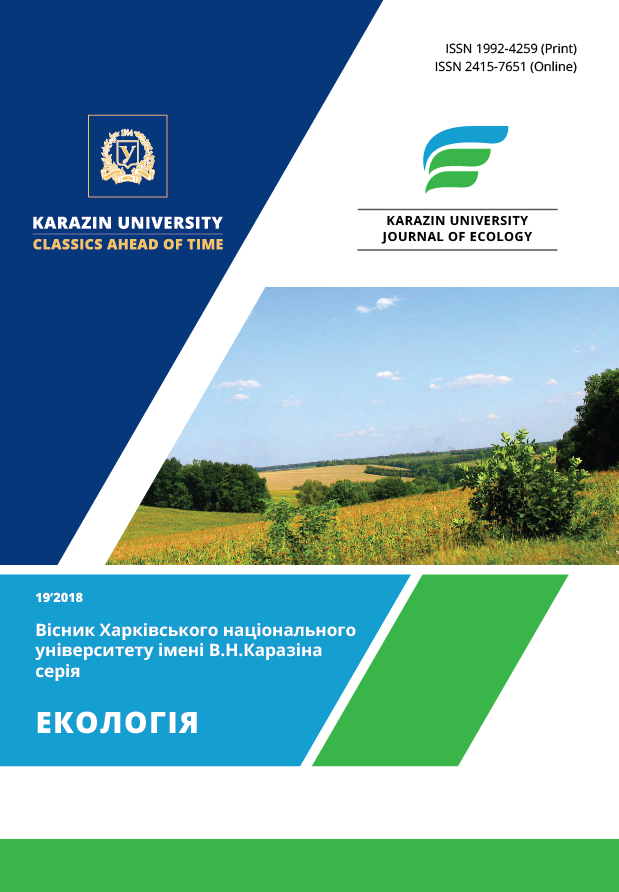Suburbal Residents’ Environmental Culture and its Connection with the Formation of Municipal Solid Waste Dumps
Abstract
The problem of environmental pollution is becoming increasingly relevant every year. It manifests itself not only at the global but also at the local level. The most common cause of these problems is the neglect of the population to the environment. This can be clearly seen in the suburban area, where there is a problem of accumulation of solid household waste and the occurrence of unauthorized dumps. In the suburban area, unlike the city, there are no necessary tools for managing the streams of solid waste. Purpose. To investigate the correlation between the level of environmental awareness of the population of the Babai village and the existing problem of landfills in this village. Results. In the course of the study, the main groups-subjects of economic activity that affect the state of the environment were identified. The survey revealed a low interest of local population in environmental issues. The introduction of environmental practices by residents of the Babai village is due more to economic than environmental reasons. Recommendations were developed for each of the identified groups of stakeholders based on the obtained data. Conclusions. In order to address the problem of solid waste accumulation in Babai, administrative, social and educational groups of decisions were proposed. Administrative decisions include an agreement with the shipping company for the creation of municipal solid waste collection system. Social decisions include awareness campaigning measures aimed at raising the level of environmental culture of the local population. Educational solutions include conducting environmental education work with pupils of the Babai secondary school. Compliance with the selected recommendations by the public and government will help to solve the existing environmental problems.
Downloads
References
Evidence that the Great Pacific Garbage Patch is rapidly accumulating plastic | Scientific Reports. Available at: https://www.nature.com/articles/s41598-018-22939-w#Sec2 [in English]
Giletckyi, Y. R. (2002). Socialno-ekonomichna z osnovamy teorii: pidruchnyk dlia 9 klasu [Geography of Ukraine. Socio-economic with the basics of the theory: a 9th grade textbook] Lviv: VNTL-Klassika, 192 [in Ukrainian]
Libanov, E. M. (2007). Smertnist naselennia Ukrainy v trudoaktyvnomu vici. In-t demografii ta socialnyh doslidgen NAN Ukrainy [Mortality of the population of Ukraine at working age. Institute of Demography and Social Studies of the National Academy of Sciences of Ukraine]. Kyiv, 211 [in Ukrainian]
Zvit pro sociologichne opytuvannia gromadian “Ohorona dovkillia ta gromadiany Ukrainy. Doslidgennia praktyk, tcinnostey ta sudgen” [Report on the polls of citizens “Environmental protection and citizens of Ukraine. Study of practices, values and judgments” Available at: http://www.rac.org.ua/uploads/content/482/files/webenvportraitfullversion2018.pdf [in Ukrainian]
Voloshyna, U. Y. (2015). Teoretychni osnovy poniatta prymiska zona ta iy osnovny vzayemozviazky z mistom [The theoretical basis of the notion of suburban area and its main interconnections with the city]. Available at: http://www.economy.nayka.com.ua/pdf/10_2015/45.pdf [in Ukrainian]
Titenko, G.V., Shy`rokostup, S.M. (2017). Prostorovi osobly`vosti upravlinnya TPV v sy`stemi "mistopry`mis`ka zona" [Spatial features of management of solid waste in the system "city-suburban area"]. Visny`k KhNU imeni V. N. Karazina seriya «Ekologiya», 17, 36-48. [In Ukrainian]
Lukina, T. O. (2012). Tekhnologia rozrobki anket dlia monitoryngovyh doslidgen osvitnyh problem: metodychni rekomendacii [Technology of questionnaire development for monitoring research of educational problems: methodical recommendations]. Mykolaiv: OIPPO, 32 [in Ukrainian]
Timonina, M. B. (2018). Derzhavna sluzhba statystyky Ukraiyny. Chyselnist nayavnogo naselennia Ukrainy na 1 sychnia 2018 roku [The number of the current population of Ukraine on January 1, 2018]. Kyiv: TOV «Avgust Treyd», 82 [in Ukrainian]
Informacia pro shkolu – Babaivska zagalnoosvitnia shkola I-III stupeniv Kharkivskoi rayonnoi rady [Infor-mation about school - Babaivska secondary school of I-III degrees of Kharkiv regional council]. Available at: http://babai.edu.kh.ua/informaciya_pro_shkolu/ [in Ukrainian]
Earth Overshoot Day – #MoveTheDate of Overshoot! Available at : http://www.overshootday.org [in Eng-lish]
Gatc ,Y. M. Problemy ekologichnogo vykhovannia molodi. Available at: http://intkonf.org/gats-yam-problemi-ekologichnogo-vihovannya-molodi [in Ukrainian]
Derzhavna sluzhba statystyky Dopovid “Demografichna sytuacia v Ukrayini v 2016 r.” [Demografic situa-tion in Ukraine in 2016]. Available at: http://www.ukrstat.gov.ua/druk/publicat/kat_u/2017/ dop/10/dop_DS_2016.zip [in Ukrainian]
Kurniak, L. M. (2015). Ekologicna kultura: poniattia ta formuvannia [Ecological culture: concept and for-mation]. Available at: http://nd.nubip.edu.ua/2015_4/8.pdf [in Ukrainian]
Samborskyi, O. S. (2009). Obgruntuvannia vyboru metodu formuvannia vybirky u doslidgenniah farmatcevtychnogo rynku [Substantiation of the choice of the sampling method in the pharmaceutical market research]. Kharkiv: FOP Petrov V. V., 27 [in Ukrainian]
Sytarov, V. A., Pustovoitov V. V. (2000). Sotcialnaya ekologia [Social ecology]. Moskow: Akademia, 280 [in Russian]
Fitcula, M. M. (2005). Pedagogika [Pedagogy]. Ternopil: Navchalna knyga – Bogdan, 232 [in Ukrainian]
Authors who publish with this journal agree to the following terms:
- Authors retain copyright and grant the journal right of first publication of this work under the terms of a license Creative Commons Attribution License 4.0 International (CC BY 4.0).
- Authors are able to enter into separate, additional contractual arrangements for the non-exclusive distribution of the journal's published version of the work (e.g., post it to an institutional repository or publish it in a book), with an acknowledgement of its initial publication in this journal.
- Authors are permitted and encouraged to post their work online (e.g., in institutional repositories or on their website) prior to and during the submission process, as it can lead to productive exchanges, as well as earlier and greater citation of published work.





